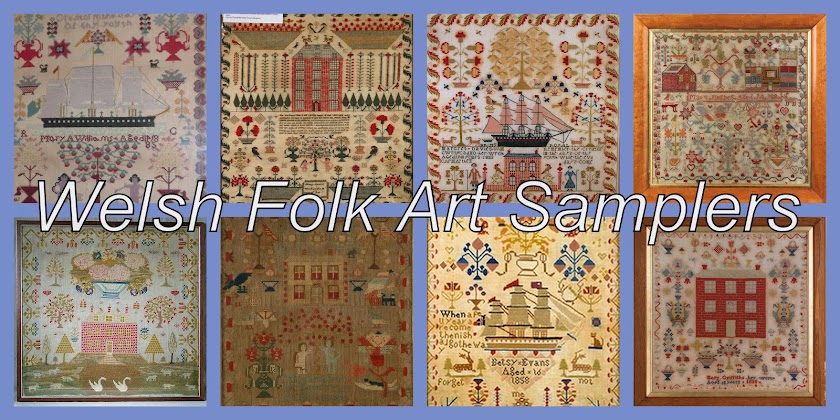Well, it has been quite a while since I posted, but I did say at the
outset that this blog would be spasmodic. Still I do feel bad that it
has been so long.
I would like to show you two samplers, one an original and the other a sampler inspired by an old sampler.
The first sampler is in the collection of St. Fagan's, the Welsh National History Museum. This museum keeps changing its name for some reason. It was first known as the Welsh Folk Museum, which I think is a much better name and then the Museum of Welsh Life. Goodness knows what they will call it next? However, they hold a very large collection of samplers and some are online at the Gathering the Jewels website - isn't that a lovely name for a site?
The Museum has credited the sampler as being made in Clunderwen in Pembrokeshire. However, the inscription is -
Anne is my name Davies is my nation Quay is my
Dwelling Place and Christ is my Salvation.
When I am Dead and laid in grave and all my bones are wrotten
In this work you'll find my name when I'll be quite
forgotten.
1889. Aged 9.
Where is Quay? Could it be Newquay in Cardiganshire?
This sampler is based on one I saw in a picture in a magazine -
I would like to show you two samplers, one an original and the other a sampler inspired by an old sampler.
The first sampler is in the collection of St. Fagan's, the Welsh National History Museum. This museum keeps changing its name for some reason. It was first known as the Welsh Folk Museum, which I think is a much better name and then the Museum of Welsh Life. Goodness knows what they will call it next? However, they hold a very large collection of samplers and some are online at the Gathering the Jewels website - isn't that a lovely name for a site?
The Museum has credited the sampler as being made in Clunderwen in Pembrokeshire. However, the inscription is -
Anne is my name Davies is my nation Quay is my
Dwelling Place and Christ is my Salvation.
When I am Dead and laid in grave and all my bones are wrotten
In this work you'll find my name when I'll be quite
forgotten.
1889. Aged 9.
Where is Quay? Could it be Newquay in Cardiganshire?
This sampler is based on one I saw in a picture in a magazine -
It was only a small picture in a room setting but I knew instantly that it was a Welsh sampler and set about trying to chart a version of it with the aid of a magnifying glass.
You will see that it has the same border as the first sampler and a similar yellow house though the proportions of roof, doors and windows are not quite the same. However, the fence and forecourt are on both samplers and though they don't share many motifs, they are ones found regularly on Welsh samplers.
It wouldn't have been fair to do an exact copy of someones sampler and neither could I because I was working under certain difficulties. The colours were quite clear but inevitably there are design changes, however, I feel that it catches the spirit of the original and I greatly enjoyed the challenge of capturing that.
The verse I chose is appropriate to Wales as our hills and pastures are clothed with sheep as well as mist and lots of rain, especially at the moment!
I now have to keep an eye open for more samplers with the same ingredients and as one of my friends has recently moved near Newquay on the Cardiganshire cost, perhaps I might urge her to keep an eye open!







